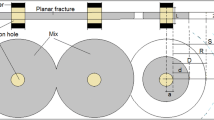Abstract
Estimating groundwater inflows in rock deep tunnels is critical to the safety of personnel constructing the tunnel and the cost of construction. This paper presents two case studies for estimating steady-state groundwater inflows into deep rock tunnels. The case studies included the Chattahoochee and Nancy Creek tunnels. In this paper, statistical methods were applied to packer test data obtained from exploratory borings during geotechnical site investigations. A semi-empirical procedure was utilized for estimating groundwater inflows into these deep rock tunnels. It is the most widely used method/procedure in the tunnel industry. The Chattahoochee and Nancy Creek tunnels are deep rock tunnels which exhibit radial flow conditions. For the radial flow condition, a statistical analysis presented in this paper indicates that the semi-empirical procedure works well; however, variations in the procedure and/or an insufficient amount of testing could lead to underestimations of the inflow quantities. Packer test data plotted in histograms were observed in all cases to be log-normally distributed for the radial flow condition. Modeling using Monte Carlo simulations was observed to be an effective tool for removing irregularities in the distribution of the data and incorporating high-end permeability data to derive reasonable groundwater inflow estimates. This paper is based on the PhD thesis entitled “Improvements to the Current State of the Practice in Steady-State, Groundwater Inflow Estimates into Rock Tunnels based on the Application of Statistical Analysis Methods of Packer Test Data obtained from Exploratory Borings During Geotechnical Site Investigations.”






Similar content being viewed by others
References
Chen R (2010) Groundwater inflow into rock tunnels. Dissertation, University of Texas - Austin
City of Atlanta (2001) Geotechnical data report – Nancy Creek tunnel. Prepared by Jordan, Jones, and Goulding, Project No. 2061.712
City of Atlanta (2003) Geotechnical data report – west area combined sewer overflow (CSO) storage tunnel facilities. Prepared by Jordon, Jones, and Goulding et al
Cobb County Water System (2000) Geotechnical baseline report – Chattahoochee tunnel project. Prepared by Jordan, Jones, and Goulding
Farhadian H, Katibeha H (2017) New empirical model to evaluate groundwater flow into circular tunnel using multiple regression analysis. International Journal on Mining Science and Technology 27:415–421. https://doi.org/10.1016/j.ijmst.2017.03.005
Goodman RE, Moye D, Van Schalkwyk A, Javandel I (1964) Groundwater inflows during tunnel driving. Presented at University of California, Berkeley, Annual Meeting of the Association of Engineering Geologists, p. 39–56
Hassania AN, Farhadian H, Katibeha H (2018) A comparative study on evaluation of steady-state groundwater inflow into a circular shallow tunnel. Tunn Undergr Space Technol 73(2018):15–25
Heuer RE (1995) Estimating rock tunnel water inflow, in G.E., Williamson and I.M. Gowring, Proceedings from Rapid Excavation and Tunneling Conference, p. 41-60
Heuer RE (2005) Estimating rock tunnel water inflow – II. Proceedings from rapid excavation and tunneling conference, p. 394–407
Katibeha H, Aalianvari A (2012) Common approximations to the water inflow into tunnels. In: Javaid MS (ed) Drainage systems, p. 75–88
Lin P, Li SC, Xu ZH, Wang J, Huang X (2019) Water inflow prediction during heavy rain while tunneling through karst fissured zones. ASCE International Journal of Geomechanics 19(8):04019093
Raymer JH (2001) Predicting groundwater inflow into hard-rock tunnels: estimating the high-end of the permeability distribution, in W.H. Hansmire and I.M. Gowring. Proceedings: Rapid Excavation and Tunneling Conference, p. 1027–1038
Raymer JH (2005) Groundwater inflow into hard rock tunnels: a new look at inflow equations. Proceedings from Rapid Excavation and Tunneling Conference, p. 457–468
Vanarelli MJ (2007) Improvements to the current state of the practice in steady-state, groundwater inflow estimates into rock tunnels based on the application of statistical analysis methods of packer test data obtained from exploratory borings during geotechnical site investigations. PhD Thesis (T-6281), Colorado School of Mines
Vanarelli MJ (2008) Statistical determinations of steady-state, groundwater inflow in rock tunnels for the radial flow condition. ASCE/Environmental and Water Resources Institute, Proceedings of the World Environmental & Water Resources Congress, Honolulu, Hawaii; Ahupua’a: Sustainability from the Mountains to the Sea. https://doi.org/10.1061/40976(316)637
Author information
Authors and Affiliations
Corresponding author
Ethics declarations
Conflict of Interest
The author declares that there are no conflicts of interest.
Additional information
Publisher’s Note
Springer Nature remains neutral with regard to jurisdictional claims in published maps and institutional affiliations.
Rights and permissions
About this article
Cite this article
Vanarelli, M.J. A Geostatistical Solution to Estimating Groundwater Inflows in Deep Rock Tunnels with Validation Through Case Studies. Mining, Metallurgy & Exploration 38, 347–357 (2021). https://doi.org/10.1007/s42461-020-00321-7
Received:
Accepted:
Published:
Issue Date:
DOI: https://doi.org/10.1007/s42461-020-00321-7




